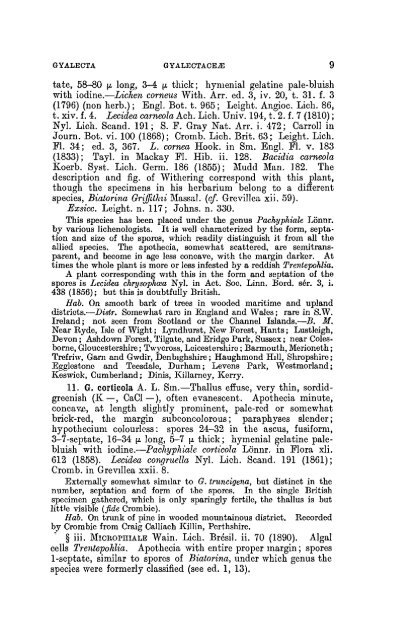BRITISH LICHENS
BRITISH LICHENS
BRITISH LICHENS
You also want an ePaper? Increase the reach of your titles
YUMPU automatically turns print PDFs into web optimized ePapers that Google loves.
GYALECTA GYALECTACElE 9<br />
tate, 58-80 (.L long, 3-4 (.L thick; hymenial gelatine pale-bluish<br />
with iodine.-Lichen corneus With. Arr. ed. 3, iv. 20, t. 31. f. 3<br />
(1796) (non herb.); Eng!. Bot. t. 965; Leight. Angioc. Lich. 86,<br />
t. xiv. f. 4. Lecidea carneola Ach. Lich. Univ. 194, t. 2. f. 7 (1810);<br />
Ny!. Lich. Scand. 191; S. F. Gray Nat. Arr. i. 472; Carroll in<br />
Journ. Bot. vi. 100 (1868); Cromb. Lich. Brit. 63; Leight. Lich.<br />
F!. 34; ed. 3, 367. L. cornea Hook. in Sm. Eng!. F!. v. 183<br />
(1833); Tayl. in Mackay Fl. Hib. ii. 128. Bacidia carneola<br />
Koerb. Syst. Lich. Germ. 186 (1855); Mudd Man. ] 82. The<br />
description and fig. of Withering correspond with this plant,<br />
though the specimens in his herbarium belong to a different<br />
species, Biatorina Griffitlni Massa!. (cf. Grevillea xii. 59).<br />
Exsicc. J.Jeight. n. 117 ; Johns. n. 330.<br />
This species has been placed under the genus Pachyphiale Lonnr.<br />
by various lichenologists. It is well characterized by the form, septa·<br />
tion and size of the spores, which readily distinguish it from all the<br />
allied species. The apothecia, somewhat scattered. are semitransparent,<br />
and become in age less concave, with the margin darker. At<br />
times the whole plant is more or less infested by a reddish Trentepohlia.<br />
A plant corresponding WIth this in the form and septation of the<br />
spores is Lecidea chrysophrxa Ny!. in Act. Soc. Linn. Bord. ser. 3, i.<br />
438 (1856); but this is doubtfully British.<br />
Hab. On smooth bark of trees in wooded maritime and upland<br />
districts.-Distr. Somewhat rare in England and Wales; rare in S.W.<br />
Ireland; not seen from Scotland or the Channel Islands.-B. M.<br />
Near Ryde, Isle of Wight; Lyndhurst, New Forest, Hants; Lustleigh,<br />
Devon; Ashdown Forest, Tilgate, and Eridgo Park, Sussex; near Colesborne,<br />
Gloucestershire; Twycross, Leicestershire; Barmouth, lVferioneth;<br />
Trefriw, Gam and Gwdir, DenbIghshire; Haughmond HIll, Shropshire;<br />
Egglestono and Teesdale, Durham; Levens Park, Westmorland;<br />
Keswick, Cumberland; Dinis, Killarney, Kerry.<br />
11. G. corticola A. L. Sm.-Thallus effuse, very thin, sordidgreenish<br />
(K -, CaCI -), often evanescent. Apothecia minute,<br />
concav.e, at length slightly prominent, pale-red or somewhat<br />
brick-red, the margin subconcolorous; paraphyses slender;<br />
hypothecium colourless: spores 24-32 in the ascus, fusiform,<br />
3-7-septate, 16-34 (.L long, 5-7 (.L thick; hymenial gelatine palebluish<br />
with iodine.-Pachyphiale corticola Lonnr. in Flora xli.<br />
612 (1858). Lecidea congruella Nyl. Lich. Scand. 191 (1861);<br />
Cromb. in Grevlllea xxii. 8.<br />
Externally somewhat similar to G. truncigena, but distinct in the<br />
number, septation and form of the spores. In the single British<br />
specimen gathered, which is only sparingly fertile, the thallus is but<br />
little visible (fide Crombie).<br />
Hab. On trunk of pine in wooded mountainous district. Recorded<br />
by Crombie from Craig Calliach Killin, Perthshire.<br />
o § iii. MICROPIIIALE Wain. Lich. Bresil. ii. 70 (1890). Algal<br />
cells Trentepohlia. Apothecia with entire proper margin; spores<br />
I-septate, similar to spores of Biatorina, under which genus the<br />
species were formerly classified (see ed. I, 13).

















